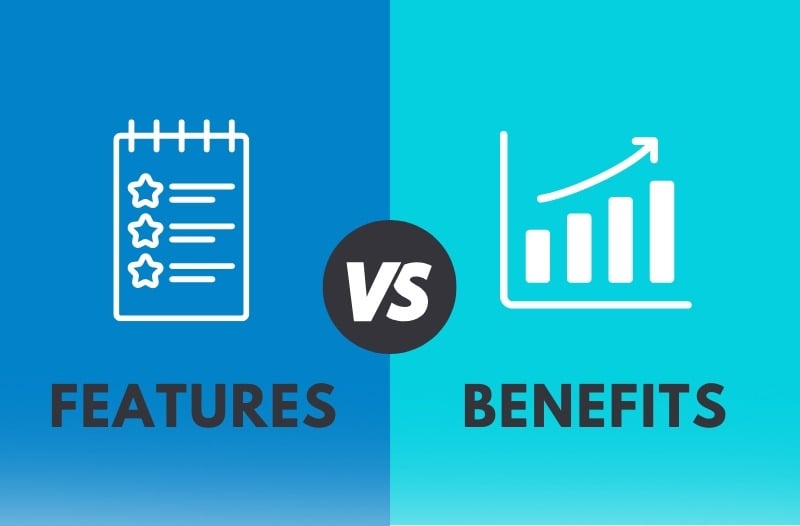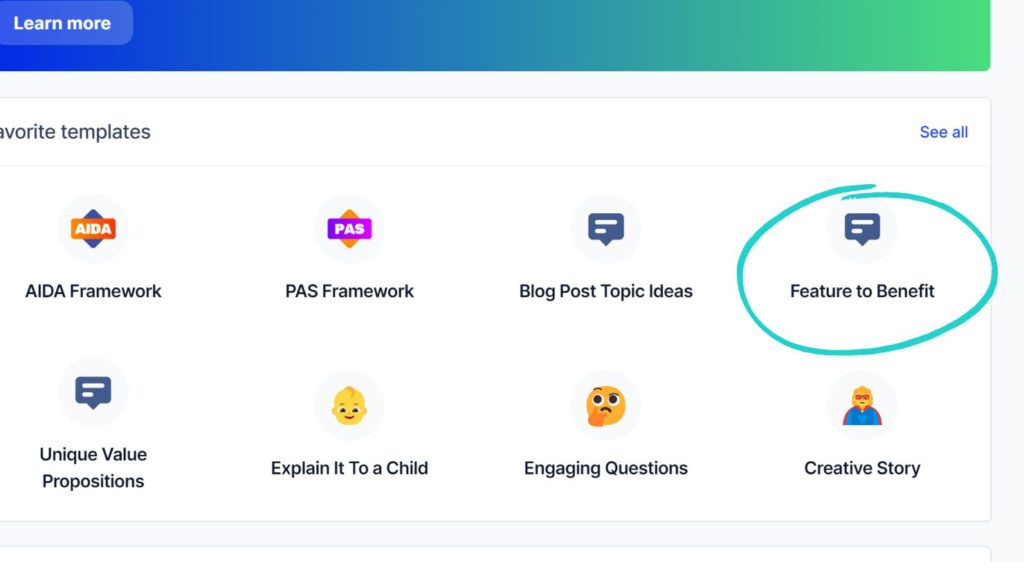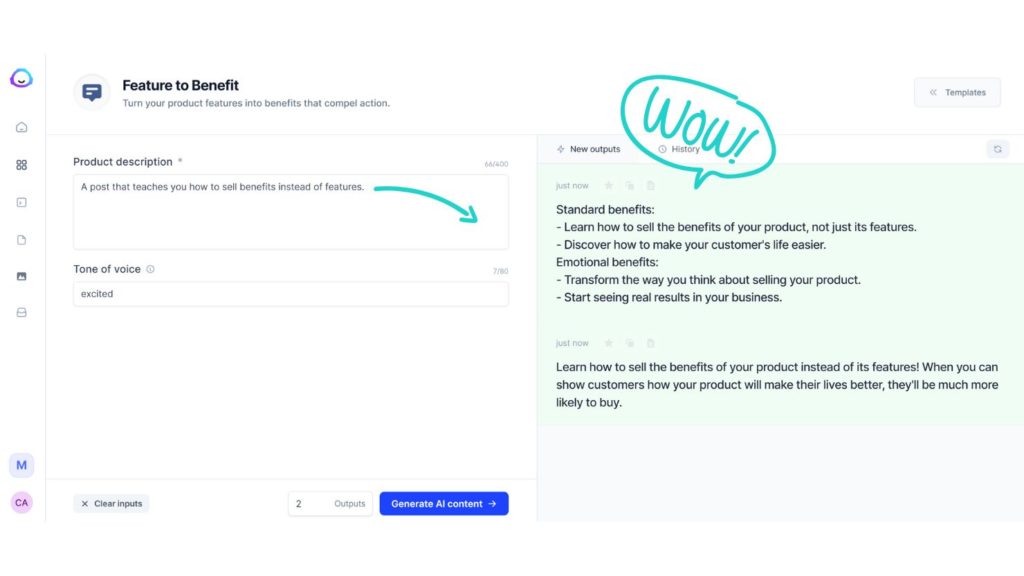Benefits versus features – it’s a common enough phrase in the business world, particularly when it comes to sales. But what does this really mean? And how are you supposed to distinguish between features and benefits?
For example, scalability. If a product tends to stay relevant and useful as your business grows, is that a benefit or a feature?
The distinction is often blurred, but coming to understand the differences between benefits and features is really important for sales.
If you can describe each of these things to your prospective customers, you’ll have a much easier time proving your business’s worth to them.
In this blog post, we’ll address how to sell benefits and not features. We’ll also define each of these things, and talk about the best way to describe the benefits and features of your product to potential customers. So, let’s get rollin’.
Benefits and Features, Defined
It’s tough to dig into the nitty gritty without having a working definition first. So to start off, let’s define what benefits and features are.
What is a feature?
Let’s go against the alphabetical order here and start off with features. In business terms, a feature is exactly what it sounds like. Features are essential functions of a product or service that help to define what it is, what it does, and its purpose.
For example, let’s take MemberPress. A feature of MemberPress is that it provides enterprising individuals and small businesses with the tools they need to monetize their WordPress sites.
What is a benefit?
A benefit is how a product's or service's features actually improve a person's life in some way.
For example, MemberPress is a stellar platform that allows for custom content paywalling and has tremendous ease-of-use (those are features). Because of these features, MemberPress remains useful even as your business scales – that's a benefit.
So, What Does it Mean to Sell Benefits Not Features?

Think about a product or service you use. Or better yet, think about your own online business.
You can probably describe its features pretty easily. What does your business do, and how does it do it?
Benefits are a bit harder to describe. Before you can describe benefits to your customers, there are two things you need to understand first:
- The product itself
- The buyer’s goals and challenges
Obviously, understanding your business is vital to being able to explain it. Beyond that, you need to understand what the customer is looking for and what challenges they face.
This is in part because each buyer is different – what one person might find beneficial is not necessarily the same for a different potential buyer. Some things you'd consider benefits might be totally irrelevant to someone else.
Here lies the main distinction between benefits and features: Features are relevant to all potential buyers. Benefits, however, can vary from person to person.
For instance, MemberPress is usable for a variety of purposes. Our creators do things like:
- Paywall high-quality content
- Create courses or quizzes
- Implement content dripping
- Create varied membership levels
- Create “buffet” style membership sites
- Offer their users customizable coupons
- And so on
And all these use cases have differing benefits. For example…
- Paywalling gives creators peace of mind that their content is protected from unpaying eyes.
- Having a built-in LMS makes it tremendously easy for building out coursework.
- Varied membership levels allow a creator to entice new members by offering some content for free.
- Content dripping keeps customers coming back for more and keeps content fresh.
As you can see, to sell features, you need to understand the product or service. To sell benefits, you need to understand the customer who’s buying it.
How to Sell Benefits Instead of Features

So, the bottom line is that benefits are more dependent on the customer than the product or service itself. It’s all about how the customer’s life is going to improve from making the purchase, rather than the things that the product does.
Is there overlap between these things? For sure! But the trick is all in the spin of the information.
If you focus your talking points on the benefits relevant to a specific person, you’ll find they’re much more likely to be interested.
Following are a few tips you can follow when trying to sell a product based on its benefits.
Understand Your Customers
I can’t overstate the importance of this one. To make an effective sales pitch, you need to understand the things your customer is interested in.
If you don’t understand your customer (and many people don’t feel understood by the businesses they buy from), you’re in trouble.
Do Your Research
Gather data to figure out what makes your customers tick. That “gathering” can take all kinds of forms – everything from surveys to interviews and social listening.
The point is to set out with the goal of figuring out what it is your customers want. Learn their hopes, dreams, thoughts, and schemes.
Once you understand your customers and what they’re looking for, you’re in good shape to pitch your product or service to them. Personalize it. Otherwise, it might come off as generic, uninteresting, or irrelevant to their circumstances.
Focus on Pain Points
Broadly speaking, pain points are specific problems your customers experience. And these are the issues your business and/or product should help to solve.

When describing your business’s benefits, you’ll find it’s a lot easier if you consider your customers’ pain points. That way, you can explain the benefits that addresses and eliminates those pain points.
Don’t Overdo It!
Say you want to create a Facebook ad to promote your online course. You’ve got about 1,200 x 1,200 pixels worth of space to hook and catch your customer. That’s not a lot of real estate to work with, so you need to be intentional.
But the good news is, when it comes to selling benefits, it’s all about quality over quantity. Your course probably offers hundreds of benefits, but you don’t need to put them all in one ad.
Consider which benefits are most relevant to the customer you want to target. Then drill down to address those one or two areas.
When you give too many benefits in a single pitch, it can come off as inauthentic and even confusing.
If you spend ten minutes talking about two benefits, you can go into pretty great detail. But if you spend the same time explaining the two ways your business can address two major pain points…
Well, like I said, quality over quantity. Be detailed, focused, and specific. Your customers are liable to thank you for it by making a purchase.
Case Study: TheGuitarLesson.com
Imagine you're Tom Fontana, the owner, proprietor, and guitarist-extraordinaire of TheGuitarLesson.com, a MemberPress-based online business.
Tom's site features over 300 video lessons, available at a variety of membership levels from free to paid. It makes great use of the MemberPress paywall to protect tons of high-quality video and instructional content.
So, if you were Tom, what would it mean to sell the benefits of TheGuitarLesson.com rather than its features? What sorts of benefits does his business offer that are worth marketing?
Well, the site's main feature is clear. It’s a platform that offers online video guitar lessons to anyone who signs up.
To some customers, a benefit of online guitar lessons could be accessibility. For example, this benefit might appeal to people living in remote areas or people with disabilities.
Accessibility would also be a benefit to a customer who doesn't have the time to go out and do in-person lessons. The flexibility to access guitar lessons whenever and from wherever could be a huge benefit to customers who have trouble clearing their schedules.
Another benefit of online music lessons might be privacy. For introverts not too keen on sharing their off-key attempts at chords with a classroom full of people, the privacy of online lessons would present a significant benefit.
Use a cheat sheet
Drilling down to benefits from features can be a little confusing until you get the hang of it. But if you need to clear up any kind of marketing confusion, there's a tried-and-true solution – the good old fashioned cheat sheet.

I typed mine up for looks, but a hand-drawn cheat sheet works just as well. Simply create a “feature” column alongside a “benefits of that feature” column, and put on your thinking cap.
You'll be surprised how quickly you can come up with a list of benefits when your site's features are presented to you in this format.
Use Artificial Intelligence
If you really want to take the easy route (and who wouldn't!), you can leave the hard work to the machines.
Jasper (aka, Conversion.ai) is an incredible AI copywriting software that creates content for you. It has all kinds of next-level templates that generate 100% original content.
One of these templates is literally called Feature to Benefit.

To use Jasper's Feature to Benefit tool, you just type in a quick description of your product and choose a tone of voice.
Click “Generate AI Content”, then Jasper gives you a list of benefits related to your product. Seems too good to be true, right?
In the screenshot below, I entered in a short description of this very blog post, and, well, see for yourself:

When it comes to long-form content, the jury's still out on Jasper. Its output does require some editing.
But for short form, it's an incredible (and surprisingly affordable) resource – especially the Benefit to Feature tool. You can click the button below for pricing info.
Conclusion
Starting an online business can be a really exciting challenge. But it can be tough to set yourself apart from the competition.
But you've got this! Just focus your marketing messages on how your business can improve people's lives, and NOT what it is your business does.
Do that, and you’ll find yourself ahead of the pack in no time.

Get MemberPress Today!
Start getting paid for the content you create.
If you liked this article, be sure to subscribe to the MemberPress blog!













Add a Comment